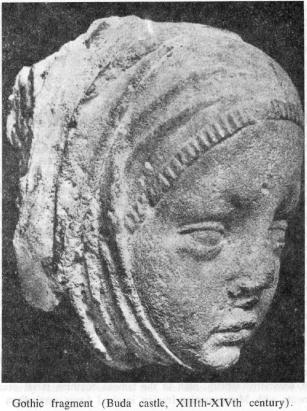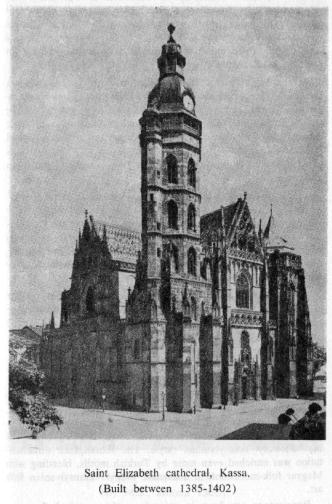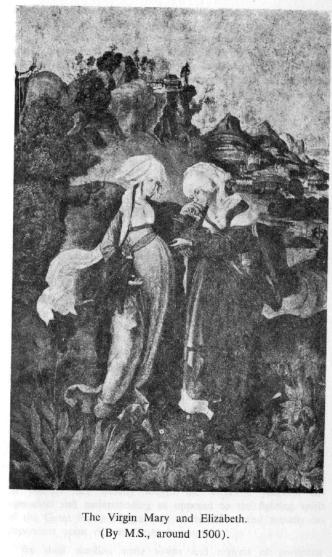| Timeless Nation |
10. THE SPLENDOUR THAT WAS...
(Hungarian art before the sixteenth century)
The ornamental articles of metal, horn and leather found in the graves of the Magyars’ ancestors show a remarkable degree of artistic interest and talent. One can detect a strong Caucasian (Alanian)–Iranian–Mesopotamian influence upon the basic Turkic-Ugrian motifs.
The richest collection of such articles is the so-called "Nagyszentmiklos treasure". These articles are believed to have belonged to one of the pre-settlement Princes. They show the Magyars’ highly developed artistic taste, an interesting synthesis of cultural influences of the migration period. This characteristically Magyar style is different from that of the Central European neighboring peoples.
The graves of the Avar-Magyars of the VIIth-IXth centuries in the present Hungarian settlement area also show a high degree of decorative artistry, akin to the famous Scythian metal ornaments with Mesopotamian-Iranian inspired figure symbolism.
The earliest Hungarian settlements in the Carpathian area were often built on the sites of Roman towns. The settlers frequently used stones, carved capitals of columns and other material taken from the impressive remnants of Roman buildings.
The influence of the western Christian art style, called ROMANESQUE, dominated the architecture of the first churches and castles, built in the Xth century, such as the Arch-abbey of Pannonhalma and the royal castles of Esztergom and Szekesfehervar. The Byzantian influence was also considerable in ornamentation, but sometimes also in style, as was the case of the first Gyulafehervar cathedral in Transylvania. The best surviving examples of the later Romanesque style are the churches of Jak, Zsambok and Lebeny (of the XIIIth century).
Some fragments of Romanesque and early Gothic fresco painting are found in the ruins of the Esztergom castle and in the undercrofts of some village churches.
Early French-Burgundian GOTHIC reached Hungary during the reign of Bela III (1172-1192), who married a French princess.
Gothic SCULPTURE survived in some places after the Mongol devastation (1241) mainly as a decorative element and relief-carving. The first sculptors in the modern sense were the Kolozsvari Brothers, who made the first freestanding bronze statues around 1370. Only one of the monumental statues has survived, the equestrian statue of Saint George (in Prague) They were probably the creators of the silver "herma" of Saint Ladislas (in Gyor). The large number of pre-Renaissance stone sculptures found recently during excavations in Buda castle show a remarkably high degree of artistic taste and workmanship. They prove that Hungarian artists of the time of Louis the Great (1342-1382) possessed consummate technical mastery and originality of expression in creating true portrait-sculpture; and this in an era (long before Donatello) when sculpture was still little more than an ornamental extension of architecture.

The characteristic gothic art of miniature painting left fine examples in the "Illuminated Chronicle" of Miklos Medgyesi (1370).
Some beautiful examples of the High Gothic period have survived in the areas not devastated by the Turks, such as the cathedrals of Kassa, (1395), Kolozsvar and Brasso. The royal castles of Visegrad and Diosgyor and later Buda were built in late gothic-early Renaissance style during the reign of the Anjou kings (XIVth century). Late gothic painting flourished under Sigismund (early XVth century). Well-known Hungarian painters of this period were Thomas Kolozsvari. Jakab Kassai, Pal Locsei and the greatest master-painter and wood carver, who only signed his work with "M.S." Beautiful examples of decorative gothic sculpture can be seen in the Bartfa and Kassa churches together with some remarkable woodcarving by some of the above mentioned artists. While most gothic structures show French influence, some churches in the west of the country were influenced by the Austrian-German gothic style.

Woodcarvings and panel painting, forms particularly suited to the Hungarian taste, has survived in many village churches, often the work of anonymous folk-artists. Hungarian goldsmiths developed the "filigree enamel" technique, creating a singular style of their own which they used on chalices, hermae and book-covers (Suky-chalice, XVth century).
King Matthias (1458-1490) was a lavish and knowledgeable patron of the arts. Hungary experienced the full impact of the RENAISSANCE under his reign, especially after his marriage to the Italian princess Beatrice. Many Renaissance artists worked in Matthias’ court and directed the rebuilding of Buda castle in "flamboyant" French gothic style with Renaissance ornamentation; they also worked on the Cathedral of Our Lady (the "Coronation" or "Matthias" church). An increasing number of talented Hungarian artists worked under these Italian masters and gradually took over. At the same time, Hungarian artists went to Italy to develop their talent, for instance the well-known "Mihaly of Pannonia".

At the height of the Renaissance, in Matthias’ later years and during the period before Mohacs (1526) both the aristocracy and the people used Renaissance inspiration in building, painting and wood paneling. Examples are found in the carving of some Transylvanian churches and in woodcarving in the so-called "Bathori Madonna". In industrial arts and crafts the synthesis of Italian and Hungarian inspiration became more and more evident.
The inspiration of Renaissance art – so close, to the pomp-loving artistic soul of the people – spread well beyond the "flamboyant" gates of Buda castle. It soon conquered the imagination of the peasant, for whom it seemed to revive the reflection of a long-forgotten eastern exuberance of colors and shapes. In its many facets, folk-art still preserves this Renaissance inspiration to the present day.

During the Turkish wars, artistic activity existed only in the non-occupied areas. In the western frontier area Italian influence prevailed (Siklos), while in the north German-inspired gothic coexisted with Italian Renaissance until the arrival of the Catholic-Austrian inspired Baroque.
In Transylvania, under the independent Princes, a late Hungarian Renaissance style developed, the ‘TRANSYLVANJAN Renascence a colorful synthesis of western and Hungarian urban and folk artistry. In the large cities of Transylvania, and in the country castles and even in village architecture, the copious use of flower-motifs gave this style later the name of the "Flowery Transylvanian" style. The Renaissance ornamentation was enriched even more by Turkish motifs, blending with Magyar folk-motifs into a distinctive Magyar-Transylvanian folk art.
Renaissance art, born in princely castles, reached the poor villages and has lived since in the Magyar peasants’ royal hearts. Most of the great creations of these periods were destroyed by the Mongols and the Turks. By a cruel turn of fate, the areas left untouched by these destroyers were allotted to the succession states in 1920 under the Treaty of Trianon. Thus, Hungary today possesses but a few pathetic relics of the splendor that was Hungarian art during the first seven centuries of the country’s existence.
| Timeless Nation |